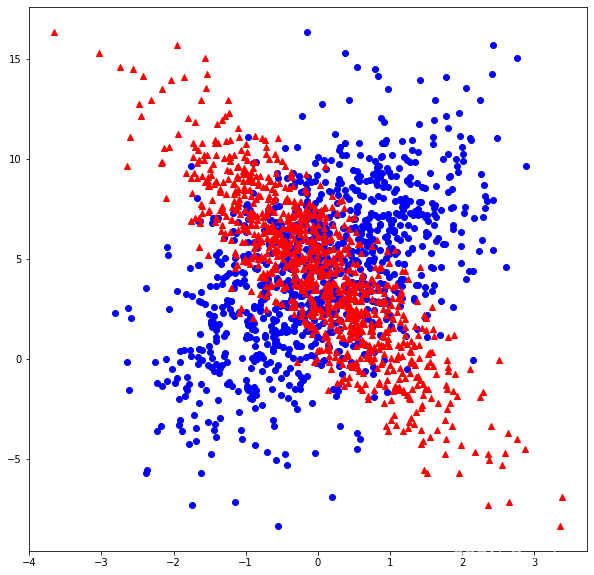线性回归从0实现
代码的实现需要这么几个过程。
- 数据
- 读入随机打乱的数据,然后要分epoch。
- 定义我们的模型,损失函数,优化算法
- 定义好超参数
- 开始 for epoch …这个过程需要根据超参数,predict pre_label,然后计算出损失的反向传播,根据优化算法去更新参数。
- 最后记得打印每次的loss,acc,auc等参数。
我们读取 ⼀小批量训练样本,并通过我们的模型来获得⼀组预测。 计算完损失后,我们开始反向传播,存储每个参数 的梯度。最后, 我们调⽤优化算法sgd来更新模型参数
构造数据
#随机生成一批数据 。y = Xw + b + ϵ. ϵ代表噪音值。
true_b = 4.2
true_w = torch.tensor([2,-3.4])
num_examples = 1000
def synthetic_data(w,b,num_examples):
X = torch.normal(0,1,(num_examples,len(w)))
y = torch.matmul(X,w)+b
y+= torch.normal(0,0.01,y.shape)
return X,y
features, labels = synthetic_data(true_w,true_b,num_examples)
labels.shape
#torch.Size([1000])
看一下构造的数据。
# 保证图片在浏览器内正常显示
%matplotlib inline
import matplotlib.pyplot as plt
plt.figure(figsize=(10,10))
plt.scatter(features[:,0],labels,marker='o',c='b')
plt.scatter(features[:,1],labels,marker='^',c='r')
plt.show()

定义数据随机读取函数:
特别注意yield字段。:yield 的函数在 Python 中被称之为 generator(生成器)
def data_iter(batch_size, features, labels):
num_examples = len(features)
indices = list(range(num_examples))
# 这些样本是随机读取的,没有特定的顺序
random.shuffle(indices)
for i in range(0, num_examples, batch_size):
batch_indices = torch.tensor(indices[i: min(i + batch_size, num_examples)])
#print(indices[i: min(i + batch_size, num_examples)])
yield features[batch_indices], labels[batch_indices]
import random
batch_size = 10
for X, y in data_iter(batch_size, features, labels):
print(X, '\n', y)
break
初始化超参数
batch_size = 10
lr = 0.03
num_epochs = 3
w = torch.normal(0, 0.01, size=(2,1), requires_grad=True)
b = torch.zeros(1, requires_grad=True)
定义模型
def linreg(X,w,b):
"""线性回归模型"""
return torch.matmul(X,w) + b
定义损失函数
def squared_loss(y_hat, y):#@save
"""均⽅损失。"""
return (y_hat - y.reshape(y_hat.shape)) ** 2 / 2
定义优化算法
def sgd(params,lr,batch_size):
#不track 梯度
with torch.no_grad():
for param in params:
param -= lr*param.grad / batch_size
param.grad.zero_()
train
net = linreg
loss = squared_loss
for epoch in range(num_epochs):
for X, y in data_iter(batch_size,features,labels):
l = loss(net(X,w,b),y)
l.sum().backward()
sgd([w,b],lr,batch_size)# 使用参数的梯度更新参数
with torch.no_grad():
train_l = loss(net(features,w,b),labels)
print(f'epoch {epoch + 1},loss {float(train_l.mean()):f}')
test
总结
pytorch backward
若在 torch 中 对定义的变量 requires_grad 的属性赋为 True ,那么此变量即可进行梯度以及导数的求解。
当c.backward() 语句执行后,会自动对 c 表达式中 的可求导变量进行方向导数的求解,并将对每个变量的导数表达存储到 变量名.grad 中
loss.sum().backward()中对于sum()的理解
一个向量是不进行backward操作的,而sum()后,由于梯度为1,所以对结果不产生影响。反向传播算法一定要是一个标量才能进行计算。
torch.no_grad()
是一个上下文管理器,被该语句 wrap 起来的部分将不会track 梯度
参考
线性回归的从零开始实现
pytorch backward() 的一点简单的理解
loss.sum().backward()中对于sum()的理解
with torch.no_grad() 详解
Python yield 使用浅析
























 1074
1074











 被折叠的 条评论
为什么被折叠?
被折叠的 条评论
为什么被折叠?










